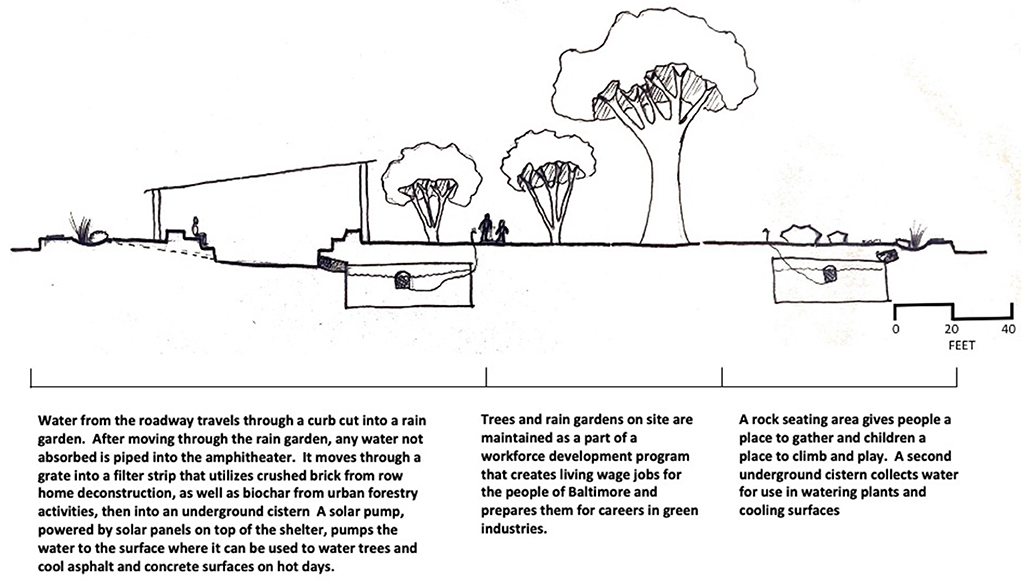- 1United States Department of Agriculture Forest Service, Baltimore, MD, United States
- 2Urban Wood Economy, Baltimore, MD, United States
- 3SavATree, Annapolis, MD, United States
- 4Arbor Day Foundation, Lincoln, NE, United States
- 5Room & Board, St. Paul, MN, United States
The field of urban ecology has progressed since the mid-1990s through four major phases: an ecology in, of, for, and with cities. This progression reflects an interest to address the complexity of urban systems with social-ecological approaches. Further, this progression signifies an interest to address societal issues by co-designing and co-producing research in collaboration with diverse stakeholders from government, non-governmental organizations (NGOs), businesses, and community associations. What remains unaddressed in this progression is a research mission orientation. While there may be a range of goals for an ecology with cities, a focus on regenerative urban ecologies is crucial. Regenerative ecologies may be seen as an endpoint along a continuum from degenerative ecologies to sustainability to regenerative ecologies. Regenerative ecologies rely upon feedback loops, similar to coral reefs and climax forests. In urban systems, these feedbacks in social-ecological systems may be considered virtuous cycles that create reinforcing, positive benefits for people and nature over time. Virtuous cycles or feedbacks are often conceived as a singular, positive feedback loop. However, virtuous cycles may be most impactful, adaptive, and resilient when they contain multiple positive and negative feedbacks and synergies. Research has several important roles in advancing virtuous cycles and regenerative urban ecologies. In this paper, we use our urban wood systems project in Baltimore as both a case study and model to illustrate an approach and lessons learned for regenerative ecologies, virtuous cycles, and the role of research. We conclude with lessons learned and consider opportunities and constraints for virtuous cycles, research, and regenerative urban ecologies in Baltimore and to other urban systems.
Introduction
Urbanization continues to grow globally in terms of area, population, and the teleconnections among urban and rural areas. The science of urban ecology has also grown significantly since the 1990s. As the field of urban ecology has developed, it has become more inclusive of disciplines and practices and open to collaboration among actors to address societal issues (Pickett et al., 2022). We propose that a new focus on regenerative urban ecologies is needed to address these combined trends of societal transitions in urbanization and an urban ecology to promote social and ecological health, wellbeing, and equity.
In this paper, we note some of the major themes of urban ecology that lead to regenerative urban ecologies. We then outline the fundamental characteristics of this focus and how it is distinct along a gradient from degenerative to sustainable urban ecologies. Cultures and practices are needed to operationalize this approach, and we discuss strategies and tools for implementing regenerative urban ecologies. We use three cases studies based upon our urban ecological work in Baltimore to illustrate this approach. First is our urban wood system approach that creates “wealth from waste” from deconstructed buildings and the city's removal of dead or dying trees. A key component of this approach is jobs for individuals who have barriers to employment from historically segregated neighborhoods. The second examines the role of one of our key partners in this urban wood system, Room & Board, and the prospects for the private sector to play a regenerative role through B Corporation approaches. Finally, our third case study completes the circle from building deconstruction to neighborhood rejuvenation by exploring the opportunity for community-based, neighborhood revitalization through the design, construction, and maintenance of parks and novel financing from social and environmental impact bonds. Within and across these three cases studies, dynamic feedbacks that create virtuous cycles are fundamental to a regenerative urban ecology approach. In the final section of this paper, we conclude by examining the generalizability of our urban wood systems approach to other urban areas in the United States, and the ability of our lessons learned for a regenerative urban ecology approach to be applied to other urban social-ecological concerns.
Sections
Trends in urban ecology
Since the 1970s, urban ecology has deployed four increasingly inclusive paradigms, from an ecology in cities to an ecology of, for, and with cities (Cadenasso and Pickett, 2013; Childers et al., 2015; Pickett et al., 2022). This progression in urban ecological paradigms is manifest along several dimensions in terms of place, time, scale, knowledges, and how knowledge is produced (Pickett et al., 2022). The shift in place is represented by moving from a focus on forests in parks to the consideration of the entire urban mosaic. The shift in time is represented by moving from considering only contemporary events to including temporal lags and legacies over centuries. The shift in scale is evident from considering only human individuals to nested hierarchies that include households, neighborhoods, municipalities, and global systems. The shift in knowledges is demonstrated by relying upon only biophysical explanations to recruiting diverse sciences and humanities for understanding. Finally, the shift in the production of knowledge is evident in transdisciplinary approaches that engage diverse communities in the co-design and co-production of knowledge (Childers et al., 2015; Zhou et al., 2017; Pickett et al., 2022). Finally, this progression in urban ecological paradigms is manifest in the fundamental conception of cities as complicated systems to conceiving of cities as complex systems that are co-produced by interacting ecological and social phenomena (Pickett et al., 2022). What is missing, however, in this progression in paradigms is a sense of mission, culture, and practice. We propose that a regenerative urban ecology is a direction to pursue.
Regenerative cultures and ecologies
Regenerative cultures and ecologies (Wahl, 2016) may be best understood in contrast to and along a continuum from degenerative to regenerative cultures and ecologies (Figure 1). In its most simple form, regenerative cultures and ecologies emphasize “leaving it better than you found it” by advancing a range of United Nations' Sustainability Development Goals (UN SDGs). Two key strategies are to “think like nature” and to employ natural components and processes. These same strategies are often referred to as biomimicry within design disciplines (Kennedy et al., 2015). Some examples of SDGs include actions to address poverty; hunger; health and wellbeing; education; equality; water and sanitation; energy; work and economic growth; industry; innovation and infrastructure; and consumption and production.
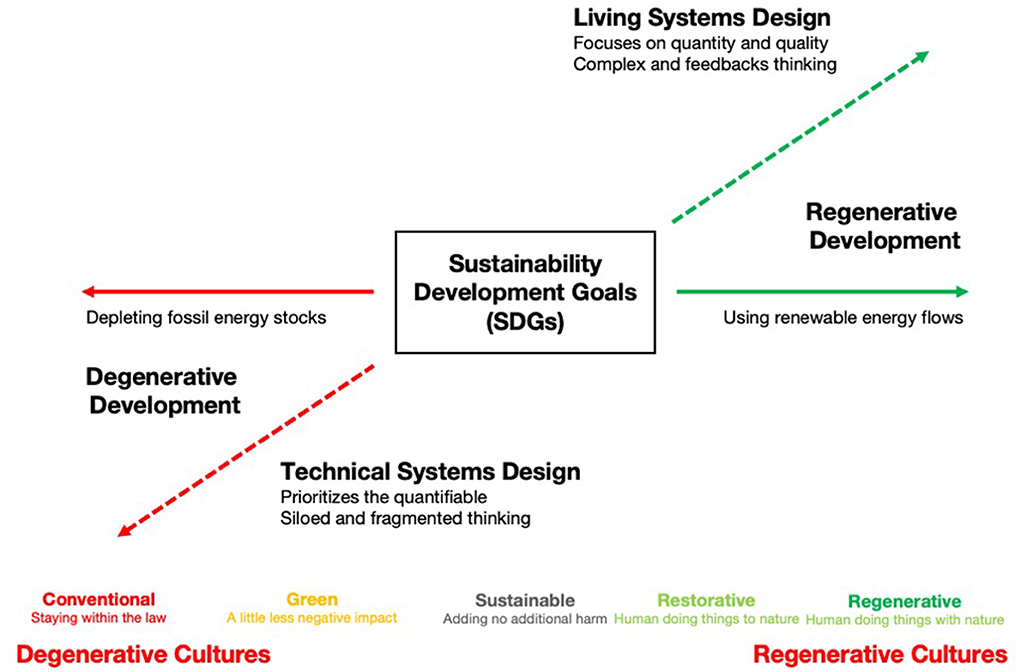
Figure 1. From degenerative to regenerative cultures and ecologies (based upon (Wahl, 2016)).
To think like nature may be rephrased as ecological thinking. A key feature of ecology and ecological thinking is its focus on the dynamic interactions among the parts of the system. An essential characteristic of these dynamic interactions is highlighted by the distinction between complicated, mechanical systems and complex, organic systems. Both complicated and complex systems can have many parts. However, complicated systems have stable structures and the interactions among the parts are deterministic and predictable (Allen et al., 2018). In contrast, complex problems have many interdependent parts and the interactions among the parts are unpredictable (Figure 2).
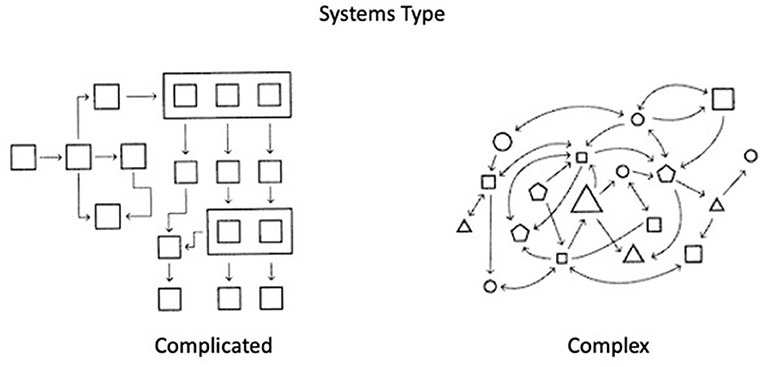
Figure 2. Systems View: the contrast between complicated and complex systems. Complicated and complex systems can both have many parts but complicated systems have stable structures and the interactions among the parts are deterministic and predictable, while complex systems have many interdependent parts and the interactions can be unpredictable.
A second key feature of ecological thinking are models of highly retentive ecosystems of energy and nutrients such as coral reefs and climax forests (Johnson, 2002; Simard, 2021). In these cases, outputs from one species are inputs to another species, and energy and nutrients are recycled and conserved in the system. To rephase in more human-centric terms, “there is very little waste”. Feedback loops are essential characteristics to highly retentive ecosystems. Feedbacks can be positive and reinforcing or accelerating such as the greenhouse effect. Feedbacks can also be negative and balancing or self-regulating such as a rheostat and the temperature of a room. In essence, positive feedbacks amplify changes in the system and negative feedbacks dampen changes in the system (Tidball and Aktipis, 2018; Tidball et al., 2018). The terms “positive” and “negative” are not normative, value statements; rather, they describe how the dynamic interactions of the system promote, regulate, or diminish growth. In social-ecological systems, both positive and negative feedbacks may be considered virtuous cycles that create reinforcing, positive benefits for people and nature over time. It is important to note that virtuous cycles are often conceived of as a singular, positive feedback loop (Morrison, 2015). However, virtuous cycles may be most impactful, self-regulating, adaptive, and resilient when they contain a combination of social, economic, and environmental outcomes (Morrison, 2015) and have multiple positive and negative feedbacks and synergies.
Strategies and tools for putting regenerative cultures and ecologies into practice
Team of Teams
Regenerative cultures and ecologies emphasize the use of nature in achieving social goals. This recalls that urban ecological systems are co-produced by ecological and social phenomena. In this case, it is important to consider what organizational social structures are needed to design and manage complex, social-ecological systems to produce virtuous cycles and positive social outcomes. As we have noted before, complicated systems have stable structures and predictable interactions among the parts. Reductionist approaches and siloed organizations can be highly effective for solving complicated problems. In contrast, complex problems have many interdependent parts and the interactions are unpredictable. Networked systems are often needed to solve complex problems (Figure 3). Further, no single organization has sufficient diversity in perspectives, motivations, and capacities to comprehensively address complex, social-ecological problems. Partnerships are needed for coordination and collaboration, often across sectors, specialties, and disciplines from government, civic organizations, business, and academia. Over time, collaborative teams that endure can develop to have their own intrinsic value. To build and sustain collaborations, we subscribe to a “Team of Teams” approach.
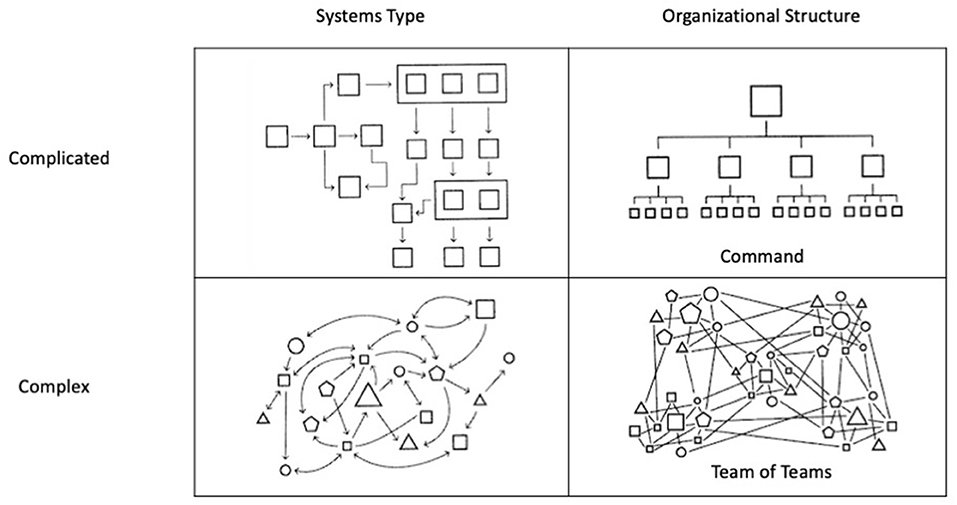
Figure 3. Systems View: Linking complicated and complex systems to organizational structures. The type of problem to be solved has important implications for the organizational structure adopted to solve the problem. Complicated problems can be broken down into its subcomponents without regard for interactions among subcomponents. In contrast, solutions to complex problems have to account for interactions among subcomponents (Inspired by McChrystal et al., 2015).
We rely on General Stanley A. McChrystal's conception of a “Team of Teams” as an essential practice for regenerative urban ecologies to tackle complex problems (McChrystal et al., 2015). General McChrystal developed his ideas around a team of teams as the Director of the Joint Staff of the Joint Special Operations Command of the U.S. military's fight against Al-Qaeda from 2003 to 2008 in Iraq. During this time, McChrystal and his staff recognized that the U.S. military was organized hierarchically, which was appropriate to solve complicated problems. However, Al-Qaeda was a networked and decentralized, complex adversary, and the task of defeating Al-Qaida presented a complex problem (Figure 3). McChrystal and his staff realized that they needed to develop the necessary social organization and teamwork for a complex rather than a complicated problem.
There are several critical features for teams, or a team of teams, to solve complex problems (McChrystal et al., 2015). Such features include specific organizational structures, cultures, and interactions among teams. Organizationally, there is a need to shift to small teams and from an emphasis on efficiency to adaptability. Culturally, what makes small teams adaptable are trust, common purpose, shared awareness, and the empowerment of individuals to act. These adaptive features are critical because they invigorate teams with an ability to solve problems that could never be foreseen by a single leader. Ideas and innovations often emerge through the bottom-up result of interactions, rather than from top-down directions. Trust is crucial within a team and among teams. Strong lateral ties are essential for developing trust and the construction of shared awareness.
Boundary objects for collaboration and building consensus for a team of teams approach
Boundary objects can be essential tools for working across sectors and disciplines to support a team of teams approach. The initial conception of boundary objects was intended to describe and understand the cooperative nature of scientific work in the absence of consensus (Star, 2010, p. 604). Star and Griesemer (1989) observed that scientific problems and their solutions often appear to be ill-structured, inconsistent, ambiguous, illogical, and complex. At the same time, science often requires cooperation among actors to create common understandings, to ensure reliability across scientific domains, and to collect information. These requirements can create fundamental conflicts between reconciling divergent viewpoints and the desire to produce generalizable findings. Thus, a key question in science, particularly when addressing ill- structured and complex problems, is how to manage diversity and cooperation among actors. These challenges appear identical to the organizational challenges for developing regenerative ecologies with a virtuous cycles framework.
Many models of cooperation assume that consensus must occur before cooperation can begin. However, teams may often develop strategies for cooperation without first requiring consensus (Star, 2010). Boundary objects can be an effective tool for building a team of teams approach. The idea of boundary objects is that they sit in the middle among different perspectives (Star, 2010, p. 608). In this usage, boundary objects are flexible and shared intellectual or physical structures that enable groups to work cooperatively and manage diversity to address ill-structured or complex problems.
Boundary objects are useful in several ways. They allow team members to cooperate and work collectively (1) without having good understandings of each other's work; (2) with different perspectives; and (3) have different goals and motivations (Cash et al., 2003). An important test of boundary objects is their ability to encompass, change, and adapt to multiple perspectives while increasing communication among perspectives (Star and Griesemer, 1989). This is an essential cultural practice for different actors in teams to conceive of and negotiate regenerative problems and to conceptualize how they fit in and identify the appropriate roles for their participation (Cash et al., 2003; Barry et al., 2008).
While Star focused on projects that primarily involved scientists, we have found the idea of boundary objects to be a valuable, practical set of tools to tackle complex problems with a team of teams approach (Figure 4). We have found four types of boundary objects to be particularly useful. We use examples here in anticipation of our case study below. Problem(s) definition can often start loosely and iteratively as team members offer their different perspectives on the problem. For instance, “how to reduce the amount of wood waste entering landfills?” requires a variety of perspectives on how wood is generated, alternative ways that it can be processed, and a range of ideas for how wood could be used. Places are often relatively familiar locales that have the same boundaries but whose contents will appear differently to different team members. Places may be multi-scaled, nested places such as an urban region and its municipalities and neighborhoods or different types of places such as the organization and linkages of wood sort yards, wood processing yards (drying and rough milling), and manufacturing shops for making products such as furniture or flooring. An example of how various people may see the same locale differently is how those charged with deconstructing buildings or removing dead trees may see the city differently from those who are interested in making furniture or those who are interested in creating job opportunities for returning citizens. System diagrams and other forms of symbolic abstraction are not intended to precisely describe the details of a place or a thing. They are abstractions from relevant knowledge domains. These diagrams “serves as a means of communicating and cooperating symbolically—a ‘good enough' road map for all parties” (Star and Griesemer, 1989, p. 410). Finally, data systems that support diverse perspectives of the place, problem, and system are a crucial tool for collaboration and understanding.
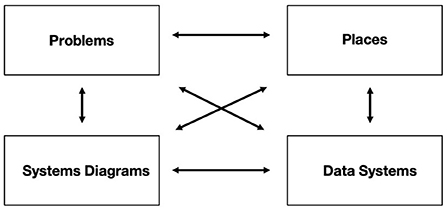
Figure 4. Four types of boundary objects. Our experience indicates the value of each type of boundary object as well as the value of using them together as an interacting system.
Star did not suggest that boundary objects be used interactively as a system. However, we have found that the value of each type of boundary object increases when used in combination with the others. Using the four boundary objects iteratively can promote novel insights as well as test, evaluate, and validate how well the team has described and understood the problem. For instance, the team might first start by trying to describe the problem. They may convert their discussion to a system diagram. The team might discuss how well the system diagram describes and maps to their place of interest. And then the team might assess how well existing data systems enable them to understand the problem, system, and place. This example is not to suggest that teams try to employ all four boundary objects simultaneously at the beginning of a project. Rather, our point is to identify these four types as useful tools and that any one of these types is a good place to start.
The development and maintenance of a team of teams and the use of boundary objects do not happen spontaneously. Both Cash et al. (2003) and McChrystal et al. (2015) emphasize the importance of organizations that act as intermediaries among sectors, specialties, and disciplines from government, non-profit organizations, business, and academia. These “boundary organizations” play several roles. They are good at mapping organizations to the combination of problem-place-systems boundary objects; helping organizations identify their place in the system; and understanding different organizations' perspectives for how they see the system, their roles, motivations, and capacities. Finally, boundary organizations often have developed skills, tools, and procedures to manage functions of communication, translation, and mediation at the boundaries among sectors, specialties, and disciplines.
Key actors for a “team of teams” approach and the use of boundary objects
To advance regenerative urban ecologies and virtuous cycles, there are several key actors for a team of teams approach and the use of boundary objects. Government agencies and civic organizations are often the principal actors in regenerative urban ecologies. We suggest that research and the private sector are underutilized and essential actors to be included. Research has several important roles to play. First, research can organize existing knowledge and data into systems understandings of key components and interactions. Here, we emphasize that these components and interactions may be both ecological and social. Given that these are complex systems, it is critical to identify linkages, feedbacks, and leverage points. Additionally, because of a team of teams orientation, organizational analysis of existing and potential partners in the system and their perspectives, motivations, and capacities is an important feature. Second is to identify uncertainties and unknowns where new research may be needed. Third is to reduce uncertainties and increase confidence for creating solutions in the form of policies, plans, and projects from multiple sectors: public, private, and civic. Fourth is to quantify positive and negative outcomes to verify the effectiveness of actions; to market the value of activities for both traditional and novel sources of investment such as pay-for-success models and social and environmental impact financing; and to support adaptive management and learning.
Finance and the private sector also have several important roles to play in regenerative cultures and ecologies. These roles are associated with recent shifts in perspectives, motivations, and capacities in finance and the private sector. First is an expanded view of how to create value. Creating value is frequently seen in terms of profits and revenues. However, value can also be created by avoiding costs, such as the cost of healthcare, crime, incarceration, trash, or water pollution. By creating financial instruments that value and pay for avoiding costs, incentives are created for developing feedbacks and tightly-coupled systems that recall the ecological thinking and complex, forested communities mentioned earlier. Second is an expanded view of financial instruments. Historically, many public, private, and civic activities and services have been paid for through taxes, profit, or philanthropy. New practices, financial instruments, and markets have recently emerged for social and environmental financing that support “pay-for-performance” activities, often focused on maximizing the avoidance of costs (e.g., Quantified Ventures, 2018, 2019). These new markets and tools are an essential means to support feedbacks in regenerative urban ecological systems.
Finally, the emergence of B Corporations and B Corporation thinking over the past 10 years signals an expanded view of corporate organization and their behaviors (Marquis, 2020). When businesses incorporate as B Corporations, their governance regime shifts from maximizing value for shareholders to maximizing value for stakeholders. In this context, stakeholders include employees, customers, society, and the environment. Crucial to environmental and social concerns, B Corporations are chartered to internalize what had been treated as environmental and social externalities—air and water pollution downstream, employees requiring public assistance because of low wages—and to perform in ways that maximize sustainability. Additionally, B Corporation culture values business to business (B2B) cooperation among B Corporations and sharing lessons learned for innovation and improving sustainability practices (Marquis, 2020) that support knowledge feedbacks in the system.
Discussion: Case study
We use our urban wood systems project in Baltimore as both a case study and model (Hines et al., 2019) to illustrate an approach and lessons learned for regenerative ecologies and virtuous cycles. Our project started with two boundary objects: Problem and Place. Our urban wood systems project originated to solve two problems in Baltimore: wood waste and unemployment. Traditionally, wood from building demolitions and tree removals in cities are treated as waste, often being disposed of in landfills. Nationally, 70.7 million tons of urban wood waste was generated in the United States in 2010, including 36.4 million tons from “Construction and Demolition Waste” such as construction, remodeling, or demolition of residential and commercial structures, and 34.3 million tons from “Municipal Solid Waste” (MSW) such as wood chips, pallets, and yard waste; tree trimming and storm damage; and construction or demolition wood. Of these 70.7 million tons, the USDA Forest Service estimated that nearly 29 million tons of wood waste (41%) was suitable for recovery and reuse rather being disposed in landfills. Our second major problem is unemployment in high poverty areas of Baltimore, particularly for individuals who have been previously incarcerated. In Baltimore, the poverty rate has increased from 18% in 1970 to 22% in 2016, over twice the average rate of about 10% across the State of Maryland. In high poverty areas, the unemployment rate ranges from 23 to 30%.
A third boundary object—Systems Diagram—is an effective way to describe and summarize existing and potential components, linkages, and team members in the project (Figure 5). There are several steps to creating a systems diagram. First is to identify the parts of the system and then the connections among the parts. The parts and the connections can be environmental, social, or economic. These connections are characterized as positive or negative. As we noted before, our use of the terms positive and negative are not meant to signal a normative value of good or bad. Rather, the terms positive and negative are used to indicate increase or decrease. For instance, a positive relationship between “deconstruction” and “wood” means that as deconstruction increases, wood increases (green arrow). And, as urban wood operations increase, wood to landfills decreases (red arrow). Subsequently, we identify existing or potential feedback loops feedback loops, which can be positive or negative as we noted earlier.
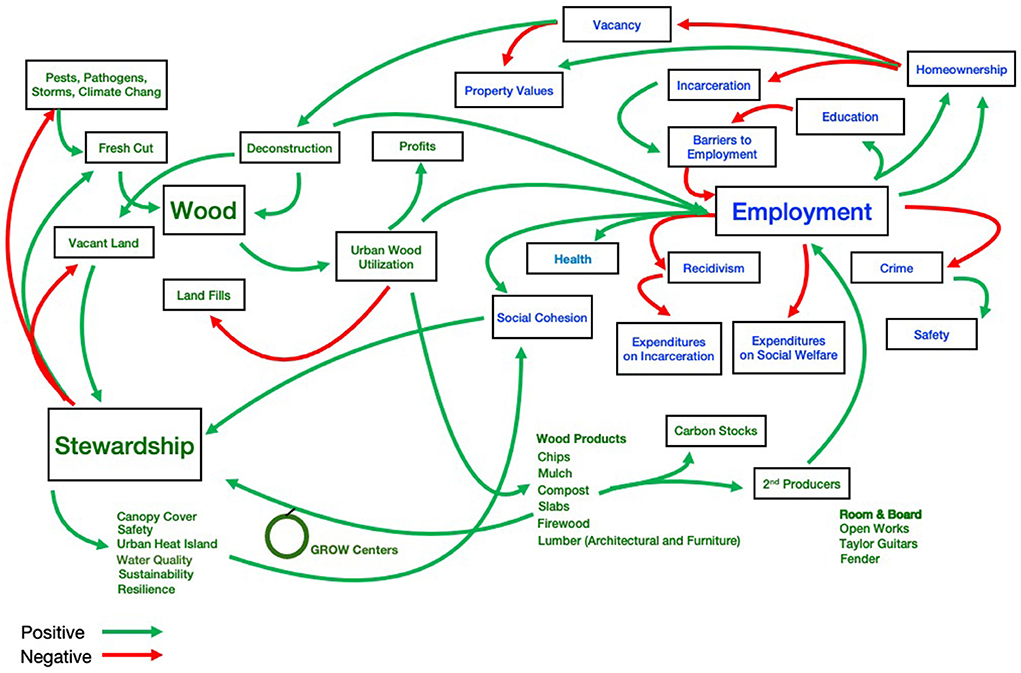
Figure 5. Baltimore urban wood systems diagram. A complex system, emerging from solving problems of Wood and Employment. Virtuous cycles are developed with both positive and negative feedbacks.
On the left side of the diagram, we start by identifying the major sources of wood (Problem) in Baltimore. We have fresh cut and deconstruction. In Baltimore, the National Renewable Energy Lab (NREL) estimates that ~78,000 tons of urban wood waste is generated each year from MSW. Vacancy and abandonment are major drivers of deconstruction. The city has identified 16,577 vacant buildings. However, the total number is estimated to be as high as 46,000 vacant buildings. For fresh cut, the City's wood yard takes in ~8,000 tons of municipal logs and chips per year.
Increasing urban wood utilization is key to diverting wood from landfills. Urban wood utilization creates wood products such as chips, mulch, compost, slabs, firewood and dimensional lumber. Wood products such as chips, mulch and compost can be used to support the Department of Public Works' GROW Centers (Green Resources & Outreach for Watersheds), which are multi-partner, mobile “pop-up” centers to promote stewardship in historically racially-excluded neighborhoods. Stewardship can address a number of issues including increasing canopy cover, promoting safety, improving stormwater water quality, and contributing to sustainability and resilience. Stewardship can also reduce vacant lands and the effects of climate change. This cycle from wood utilization has both positive and negative feedback loops by reducing wood waste to landfills and the extent of vacant lands, and increasing stewardships to produce positive benefits and reduce drivers of climate change.
On the right side of the diagram, we start by identifying factors affecting employment in high poverty areas of Baltimore, particularly for individuals who have been previously incarcerated. The city's incarceration rate of 1,255 out of every 100,000 people is three times higher than both the state and national averages. Baltimore City residents comprise 10% of Maryland's general population but 33% of its prison population. Two major barriers to employment are education and incarceration. Increasing education decreases barriers, while increasing incarceration increases barriers. Increasing employment decreases crime and increases safety. Employment decreases recidivism and expenditures on incarceration and social welfare. The state of Maryland spends $300 million each year to incarcerate people from Baltimore City at a cost of ~$38,000 per inmate. Former inmates often return. Estimates suggest that 73% of citizens returning from prison to Baltimore are incarcerated again within 3 years.
Increasing employment can also increase education through employer reimbursements as well as lead to homeownership and increasing property values. Employment and wood connect through people being employed in deconstruction, wood utilization, and “2nd Producers” who make things such as home furnishings, furniture, and flooring. Employment is also connected to wood by increasing homeownership, which decreases vacancy, and then decreases the need for deconstruction. A key lesson from this illustration and analysis is that there can be numerous, virtuous cycles that consist of multiple, positive and negative feedback loops.
Our systems diagram has been essential to advance a team of teams approach, working among sectors, specialties, and disciplines from government, non-profit organizations, community groups, business, and academia. Key players include the non-profit organization, Humanim, its subsidiaries Details and Brick + Board, community partners from the Station North and Johnson Square neighborhoods, government agencies at local (Baltimore City Division of Forestry and Departments of Housing and Community Development and Public Works), state (MD Departments of Housing and Community Development and Natural Resources' Forest Service) and Federal levels (USDA Forest Service), private sectors including the home furnishings company Room & Board and the consulting firm Quantified Ventures,. These sectors brought key perspectives and knowledges from wood, wood processing, and wood making; job training and employment, and social-environmental valuation and analysis.
Systems diagramming enabled team members to contribute their expertise and question the team's collective understanding. We could then identify additional information needs and uncertainty as well as improve our operations and maximize the feedbacks that produce virtuous cycles. It also enabled us to communicate the diversity of benefits and outcomes and attract new members to the team, particularly those who were interested in creating value by avoiding costs associated with landfills, incarceration, crime, and stormwater pollution. Finally, the systems diagram as a data system (fourth boundary object type) has two important roles. First, it enabled us to quantify and communicate the diversity and magnitude of direct social, economic, and environmental outcomes in terms of monetary value. This can be crucial for reshaping policies and regulations as well as attracting social and environmental impact investment. Second, it supported adaptive management through monitoring and evaluation.
Phase II: Completing and expanding cycles of “what could be”
We shift from what has already been accomplished in the urban wood systems in Baltimore to opportunities to complete and expand new cycles. From our existing systems diagram (Figure 5), we focus on two components: the role of Room & Board and its potential role in circular economies, and land reclamation of vacant lots as a specific form of Stewardship. These two examples address several interconnected problem areas: how to invest and support circular economies; how to convert wood materials from low value to high value; how to restore vacant, degraded lands; and how to adapt to climate change.
Room and board and its potential role in circular economies
Our first example focuses on the perspectives and motivations of one of our team members, the private sector company Room & Board. We conceive of this example in terms of a virtuous, circular economy of tree planting, maintenance, and removals and the role that Room & Board could play to advance a regenerative urban ecology (Figure 6). In this example, we first return to the tenets of B Corporations that we discussed earlier. Although Room & Board is not a B Corporation, it can still adopt B Corporation thinking, including a shift from shareholders to stakeholders, business to business collaborations among B Corporations, and shared learning within and among sectors. Room & Board is already well-positioned to adopt a B Corporation approach for several reasons. First, Room & Board already has a stakeholder approach. It is positioned primarily in the U.S. for almost all of its materials and production. The company cultivates and values its long-term relationships with its makers, who are often small firms. It also cultivates and values its relationships with its employees and customers. Finally, the company has a long-term, sustainability ethic in terms of both its products and the environment. The question remains, however, how could a company like Room & Board go from a sustainable to a regenerative approach (re: Figure 5).
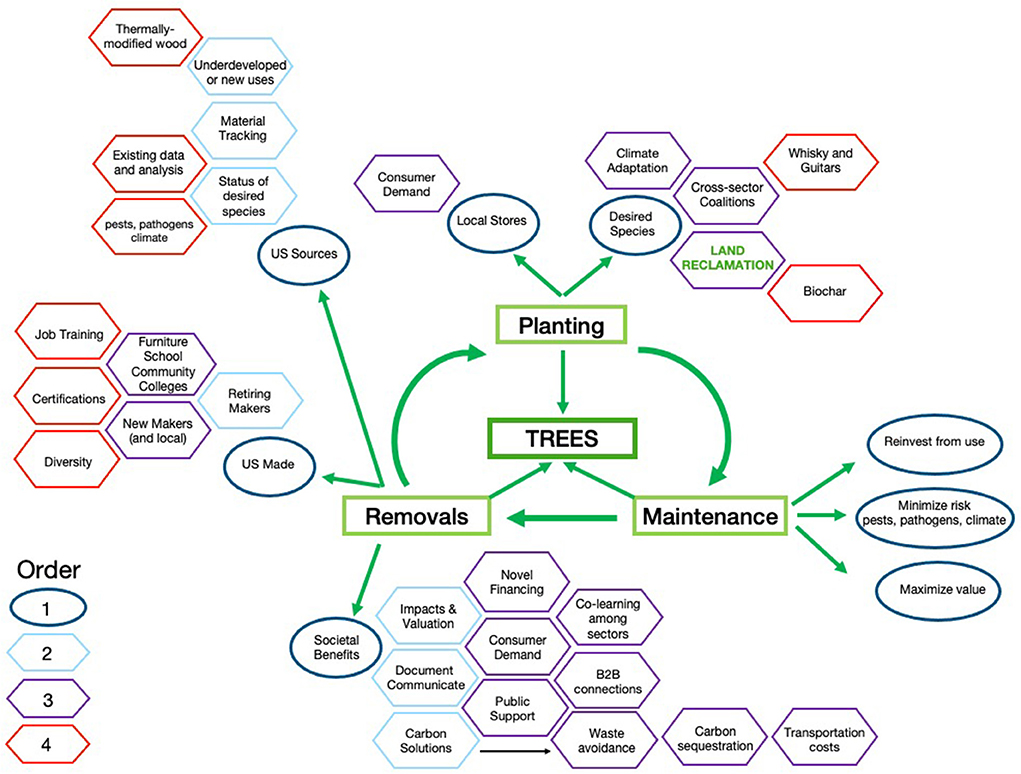
Figure 6. Room and Board and its potential role in circular economies. Understanding the perspectives and motivations of specific actors in the urban wood systems (re. Figure 4) can be used to analyze how they can engage with the virtuous cycle of tree planting, maintenance, and removals.
At the center of this circular economy is the organizing idea of a regenerative, healthy, and climate adapted canopy of trees in urban areas. This involves three primary activities: tree planting, maintenance, and removals (Figure 5). The diagram is organized into first through fourth order levels of interaction. We start with tree removals because this is the initial point of contact that Room & Board has with urban trees. For removals, the first order items are U.S. Sources, U.S. Made, and Societal Benefits.
Room & Board sources most of the materials for its wood products from the United States. The primary wood species they use are white oak, ash, maple, and walnut. Given its long-term dependence on these species, it is crucial to understand the current status of these species in terms of quantities and quality, supply chains, and potential future threats due to pests, pathogens, and climate change. Room & Board could partner with government agencies and universities to analyze current conditions and forecast long term trends in supply and possible alternatives if species supplies are at risk. A second area of focus is the development of novel, material tracking systems. These tracking systems can be used in two ways. First is to track wood from the initial source to the final product. Here, the goal is to retain the value of the sustainability story from the address where the tree had lived, to who made the product, to its eventual arrival at a home. This could add significant value because urban wood makers have found that there can be as much as a 40% increase in the value of their products if they can include the origin and journey of the wood. The second reason for material tracking systems is that individual, urban wood systems are often not sources of large volumes of high-quality material. Thus, there is the need to aggregate within urban wood systems and even regionalize among urban wood systems. For instance, there may be the need for regional aggregation of white oak from cities extending from Richmond, VA to Philadelphia, PA to meet the quality and quantity needs of a regional or national maker. Thus, material tracking systems enable local urban wood systems to develop through participation in regional aggregation markets. Finally, there is the need to explore underdeveloped or new uses for wood. For instance, some tree species are widely available but have often not been desirable for furniture making. In the mid-Atlantic of the United States, tulip poplar (aka yellow poplar) is an example of an undesirable species for furniture making. However, tulip poplar can be cut to dimensions and dried through thermal modification to be rot resistant for outdoor uses. This converts a low-value species to a high-value product and reduces the dependence on tropical wood imports for outdoor furniture.
Making products in the U.S. is becoming challenging as the owners of the small firms that Room & Board traditionally works with are retiring. While this creates challenges, it also creates opportunities. Room & Board could develop new partnerships with existing makers, particularly makers who may be local to urban wood sources and Room & Board stores. They could also partner with training programs for new makers, such as furniture schools and community colleges. These programs can be essential for job training and certifications, expanding the workforce of makers. Room & Board could also support scholarships to support workforce diversity.
Societal benefits involve the ability to measure and value the impacts of Room & Board's regenerative activities. This is key for transparency and the ability to attract novel financing for Room & Board and its partners. The ability to document and communicate the social benefits could increase consumer demand for its products and build support for regenerative approaches, particularly those that involve the private sector. The ability to measure and communicate also connects to co-learning among sectors and establishing business-to-business partnerships among B Corporation aligned companies. Finally, carbon solutions are a societal benefit, which occurs through avoiding waste (re. Figure 5), sequestering carbon in durable wood goods, and minimizing transportation costs if the distance among wood sources, manufacturing, and customers is minimized.
Tree planting is a major component of this virtuous, urban tree cycle. Room & Board could invest profits from their use of tree removals to support local tree planting organizations in locations where they source their wood or have their stores, such as Baltimore, MD, Sacramento, CA, Austin, TX or Boston MA. These local investments could also create opportunities to engage and activate local customers to participate in local tree planting activities and increase local customer interest in Room & Board products. As trees are planted, it is important to consider desired species to promote climate adaptation, their use when they reach the end of their life cycle, and their use for land reclamation. Cross-sector coalitions may provide valuable input and investments in tree planting. For instance, the whisky industry depends upon white oak for its barrels, and guitar makers seek ash and other desirable tonal woods for their acoustic guitars. Land reclamation could involve new planting and soil amendments with biochar for establishing trees and improving stormwater quality (we discuss this further in our next example).
Tree maintenance is the third major component of this cycle. Profits from tree removals could again be used to support this component. Support for maintenance could be used to minimize risk to pests, pathogens, and climate change to extend the life of trees. Maintenance through pruning could also maximize the value of trees for when they must be removed.
Neighborhood revitalization through land reclamation of vacant lots
Our third case study completes the circle from building deconstruction (re. Figure 5) to neighborhood rejuvenation by exploring the opportunities for community-based, neighborhood revitalization through the regenerative design, construction, and maintenance of parks and novel financing from social and environmental impact bonds. Our example draws from the work of The Parks & People Foundation and its community partnership projects in historically racially-segregated neighborhoods such as McKean and Johnston Square neighborhoods (Place). These neighborhoods face a number of problems, including vacant buildings and vacant lands; unemployment; crime; absence of parks and green spaces; financial resources to build and maintain green spaces; and vulnerability to climate change such as flooding from microbursts of precipitation, heatwaves, droughts, and severe storms that can cause loss of electricity. Figure 7 shows the progression from vacant buildings to deconstruction and land clearance, and a new, neighborhood park.
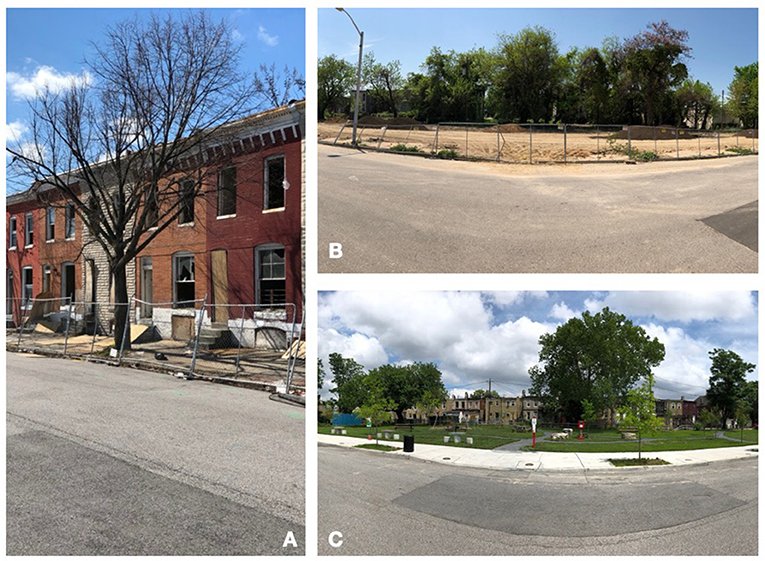
Figure 7. Vacant buildings, deconstruction, and revival for McKean Park. (Photos: J. Morgan Grove, USDA Forest Service). Vacant buildings (A), deconstruction (B), and revival (C) for McKean Park.
Figure 8 illustrates how these types of neighborhood parks could be designed and maintained to address these multiple problems with a regenerative, integrated design. For instance, the design offers an attractive community space integrated with rainwater capture, treatment, and storage; solar panels for micro-grid electricity; and the ability to avoid societal costs that could be captured with social and environmental impact bond financing to support the design, construction, and maintenance of the park. We use a systems diagram to illustrate the systems design of the park (Figure 9).
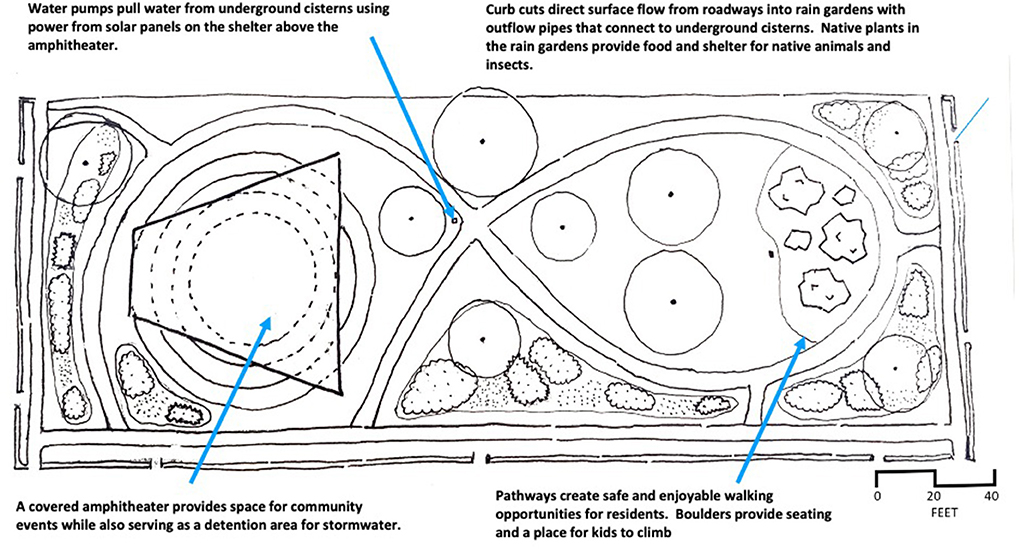
Figure 8. Plan and section for a park as a regenerative, social-ecological system for neighborhood revitalization.
Our regenerative, systems design for neighborhood parks retains components and feedbacks from our urban wood systems, particularly the Employment section (re. Figure 5). New to this systems diagram is the general benefits that neighborhood parks can play to reduce vacancy and increase human health and social cohesion. Particular to this regenerative, systems design are the added features to address the many negative effects of climate change that are and will be experienced in vulnerable urban communities. These climate effects include increased precipitation, particularly microbursts, which increase flooding and reduce the water quality of stormwater runoff; increased drought which reduces plant health and the capacity of vegetation to cool the neighborhood through evapotranspiration; increases in the number and severity of heatwaves, which lead to human mortality or illness; and severe storms, which can lead to loss of electrical supply.
Water capture through curb cuts and the amphitheater roof, and water storage through below-ground cisterns reduce flooding. Water treatment through a filter system of crushed brick and biochar to improve stormwater quality. Energy from the solar panels on the amphitheater roof power pumps from the cistern to irrigate park trees, plants, and grass and adjacent street trees, which reduce the effects of drought. The trees, plants, and grass help to cool the neighborhood, which is particularly beneficial during heatwaves. Additionally, water from the cisterns can be applied to and cool impervious asphalt and concrete surfaces such as streets, which can reduce the local effects of heatwaves from 10° to 15°F. The energy from these solar panels can also be used after storm events and the loss of electricity to recharge phones and other devices. Further, construction costs would be reduced by reusing crushed brick in the water filters, paths, and amphitheater from building deconstruction and biochar in the water filters and as a soil amendment from wood utilization operations (re. Figure 5).
The park design features we outline produce substantial “avoided costs” in healthcare to treat people for heatwave related illness and stormwater mitigation associated with the city's MS4 compliance requirements. These avoided costs can be quantified and monetized through social and environmental impact bonds to finance employment for park design, construction, and maintenance. Additional “avoided cost” benefits could be researched and calculated for reducing stress and crime and increasing government revenues from increased property values.
Conclusion
We conclude by examining the generalizability of our urban wood systems approach to other urban areas in the United States, and the ability of our lessons learned for a regenerative urban ecology approach to be applied to other urban social-ecological problems. The generalizability of the Baltimore urban woods systems can be characterized in several ways: opportunity, quantification, and dissemination. In terms of opportunity, there are substantial quantities of urban wood in terms of supply, production, and demand on a national basis. In the near term, we anticipate increasing supplies of urban fresh cut from increasing mortality due to pests, pathogens, storms, and climate change. For instance, a recent study forecasts that 1.4 million street trees in urban areas and communities will be killed by introduced insect pests by 2050. This represents 2.1–2.5% of all urban street trees (Hudgins et al., 2022). In the long term, trees being planted now as part of “1 Million Tree” initiatives in cities will result in significant tree removals in 50–70 years. We are also likely to see changes in production as companies seek to minimize overseas supply chain vulnerabilities and to maximize and market the sustainability of their products to their customers. Demand from customers is also likely to grow due to the changing characteristics of consumers, particularly younger consumers, who are demanding that their materials be sustainably sourced and produced.
In terms of quantification, the generalizability of our urban wood utilization approach depends upon the ability to apply our systems approach to other locations by identifying potential team members; targeting interventions; quantifying the diversity and magnitude of direct social, economic, and environmental outcomes, and monetizing those outcomes for government, civic, and private sector investments (Morrison, 2015). Intriguingly, Morrison (2015) suggests that the support for and resilience of a virtuous cycles solution increases as the diversity and quantification of social, economic, and environmental outcomes increases. Although we are only one example, our experience supports this idea. Finally, in terms of dissemination, strategies and mechanisms for diffusion and adoption are crucial for a regenerative approach to urban wood utilization can become widespread. An urban wood network has already emerged that connects passionate champions and boutique operations into chapters that can aggregate to a national network of networks. The USDA Forest Service has emerged as a boundary organization that supports this network of networks through websites, multi-media products, and “Urban Wood Academies” to share knowledge, practices, and lessons learned and to promote network collaborations. In addition to the technical aspects of urban wood utilization, organizational and financial training are key for employing a team of teams approach, the use of boundary objects, and accessing novel financial investments.
Several “lessons learned” have emerged from our efforts. We believe these lessons may be generalizable to a diverse range of complex social-ecological problems. A systems view is crucial to address the complexity of social-ecological problems for several reasons. First, a complex systems view (Figure 2) encourages the team to engage the numerous positive and negative feedback loops necessary to advance what will likely be multiple and interacting virtuous cycles. This leads to an openness and aspiration to address multiple SDGs and produce one solution to solve many problems. Yet, not everything can be accomplished at the beginning of a project; so it is valuable to acknowledge challenges, aspirations, and “not-quite-ripe” situations.
A team of teams approach is critical for tackling complex, social-ecological problems, and boundary objects are useful tools to collaborate and eventually build consensus. This combination of a team of teams and boundary objects enables the diversity of team members to contribute their particular knowledges and perspectives to a greater and more complete whole. This is valuable because many of the most complex undertakings are never done by a single entity. Complex problems often require an interdependent mix of operational expertise, research, financing, and stakeholder engagement. While not mentioned earlier, in addition to trust, humility is an important characteristic for team members to bring to this collective work. Finally, there is a science and resources for training in transboundary practices and culture that needs to be more widely adopted (Gordon et al., 2019; Bammer et al., 2020).
Author contributions
MGr led the writing of the manuscript. SH, JC, MGa, GW, and LM provided ideas, content, and editing. LM provided the ideas and drawings for the land reclamation case study. All authors contributed to the article and approved the submitted version.
Funding
USDA Forest Service provided support for this research and open access.
Conflict of interest
Author JC was employed by Urban Wood Economy. Author MGa was employed by SavATree. Author GW was employed by Room & Board.
The remaining authors declare that the research was conducted in the absence of any commercial or financial relationships that could be construed as a potential conflict of interest.
Publisher's note
All claims expressed in this article are solely those of the authors and do not necessarily represent those of their affiliated organizations, or those of the publisher, the editors and the reviewers. Any product that may be evaluated in this article, or claim that may be made by its manufacturer, is not guaranteed or endorsed by the publisher.
Author disclaimer
The findings and conclusions in this article are those of the author(s) and should not be construed to represent any official USDA or U.S. Government determination or policy.
References
Allen, T. F. H., Austin, P., Giampietro, M., Kovacic, Z., Ramly, E., and Tainter, J. (2018). Mapping degrees of complexity, complicatedness, and emergent complexity. Ecol. Comp. 35, 39–44. doi: 10.1016/j.ecocom.2017.05.004
Bammer, G., O'Rourke, M., O'Connell, D., Neuhauser, L., Midgley, G., Klein, J. T., et al. (2020). Expertise in research integration and implementation for tackling complex problems: when is it needed, where can it be found and how can it be strengthened?. Palgrave Commun. 6, 1–16. doi: 10.1057/s41599-019-0380-0
Barry, A., Born, G., and Weszkalnys, G. (2008). Logics of interdisciplinarity. Econ. Soc. 37, 20–49. doi: 10.1080/03085140701760841
Cadenasso, M. L., and Pickett, S. T. A. (2013). “Three tides: the development and state of the art of urban ecological science,” in Resilience in Ecology and Urban Design: Linking Theory and Practice for Sustainable Cities, eds. S. T. A. Pickett, M. L. Cadenasso, and B. McGrath (New York, NY: Springer), 29–46.
Cash, D. W., Clark, W. C., Alcock, F., Dickson, N. M., Eckley, N., Guston, D. H., et al. (2003). Knowledge systems for sustainable development. Proc. Natl. Acad. Sci. 100, 8086–8091. doi: 10.1073/pnas.1231332100
Childers, D. L., Cadenasso, M. L., Grove, J. M., Marshall, V., McGrath, B., and Pickett, S. T. A. (2015). An ecology for cities: a transformational nexus of design and ecology to advance climate change resilience and urban sustainability. Sustainability 7, 3774–3791. doi: 10.3390/su7043774
Gordon, I. J., Bawa, K., Bammer, G., Boone, C., Dunne, J., Hart, D., et al. (2019). Forging future organizational leaders for sustainability science. Nat Sustain. 2, 647–649. doi: 10.1038/s41893-019-0357-4
Hines, S. J., Marshall, L., and Grove, J. M. (2019). Rebuilding Communities through an Urban Wood and Land Restoration Economy. Anne Arbor, MI: Michigan Sustainability Cases, University of Michigan.
Hudgins, E. J., Koch, F. H., Ambrose, M. J., and Leung, B. (2022). Hotspots of pest-induced US urban tree death, 2020–2050. J. Appl. Ecol. 59, 1302–1312. doi: 10.1101/2021.04.24.441210
Johnson, S. (2002). Emergence: The Connected Lives of Ants, Brains, Cities, and Software. New York City, NY: Simon and Schuster.
Kennedy, E., Fecheyr-Lippens, D., Hsuing, B.-K., Niewiarowski, P. H., and Kolodziej, M. (2015). Biomimicry: a path to sustainable innovation. Design Issues 31, 66–73. doi: 10.1162/DESI_a_00339
Marquis, C. (2020). Better Business: How the B Corp Movement Is Remaking Capitalism. New Haven, CT: Yale University Press.
McChrystal, G. S., Collins, T., Silverman, D., and Fussell, C. (2015). Team of Teams: New Rules of Engagement for a Complex World. New York City, NY: Penguin.
Morrison, S. A. (2015). A framework for conservation in a human-dominated world. Conserv. Biol. 29, 960–964. doi: 10.1111/cobi.12432
Pickett, S. T., Cadenasso, M. L., and Rademacher, A. M. (2022). Coproduction of place and knowledge for ecology with the city. Urban Ecosyst. 25, 765–771. doi: 10.1007/s11252-021-01190-8
Quantified Ventures (2018). U.S. Forest Service: Urban Wood Disposition Pay-for-Success Feasibility Report 1875. Washington, DC 20009. Available online at: www.quantifiedventures.com (accessed June 19, 2022).
Quantified Ventures (2019). Fresh Cut. The Business Viability of Processing Freshly Cut Urban Wood in Baltimore City 1875. Washington, DC. 20009. Available online at: www.quantifiedventures.com
Simard, S. (2021). Finding the Mother Tree: Uncovering the Wisdom and Intelligence of the Forest. London: Penguin UK.
Star, S. L. (2010). This is not a boundary object: Reflections on the origin of a concept. Sci. Technol. Hum. Values 35, 601–617. doi: 10.1177/0162243910377624
Star, S. L., and Griesemer, J. R. (1989). Institutional ecology, translations and boundary objects: amateurs and professionals in Berkeley's Museum of Vertebrate Zoology, 1907-39. Soc. Stud. Sci. 19, 387–420. doi: 10.1177/030631289019003001
Tidball, K. G., and Aktipis, A. (2018). Feedback enhances greening during disaster recovery: a model of social and ecological processes in neighborhood scale investment. Urban Forestry Urban Green. 34, 269–280. doi: 10.1016/j.ufug.2018.07.005
Tidball, K. G., Metcalf, S., Bain, M., and Elmqvist, T. (2018). Community-led reforestation: cultivating the potential of virtuous cycles to confer resilience in disaster disrupted social–ecological systems. Sustainabil. Sci. 13, 797–813. doi: 10.1007/s11625-017-0506-5
Keywords: regenerative, urban, ecology, Baltimore, wood, virtuous
Citation: Grove M, Carroll J, Galvin M, Hines S, Marshall LL and Wilson G (2022) Virtuous cycles and research for a regenerative urban ecology: The case of urban wood systems in Baltimore. Front. Sustain. Cities 4:919783. doi: 10.3389/frsc.2022.919783
Received: 13 April 2022; Accepted: 05 July 2022;
Published: 02 August 2022.
Edited by:
Michele Romolini, Loyola Marymount University, United StatesReviewed by:
Kirsten Schwarz, University of California, Los Angeles, United StatesKeith Gordon Tidball, Cornell University, United States
Copyright © 2022 Grove, Carroll, Galvin, Hines, Marshall and Wilson. This is an open-access article distributed under the terms of the Creative Commons Attribution License (CC BY). The use, distribution or reproduction in other forums is permitted, provided the original author(s) and the copyright owner(s) are credited and that the original publication in this journal is cited, in accordance with accepted academic practice. No use, distribution or reproduction is permitted which does not comply with these terms.
*Correspondence: Morgan Grove, am1ncm92ZUBnbWFpbC5jb20=
 Morgan Grove
Morgan Grove Jeff Carroll2
Jeff Carroll2 Michael Galvin
Michael Galvin